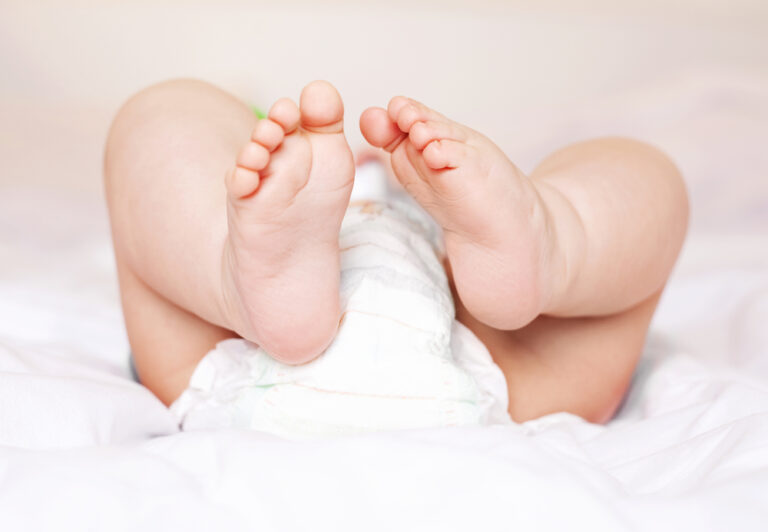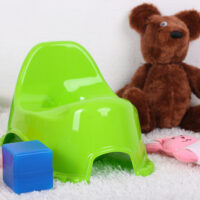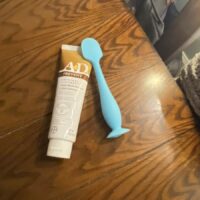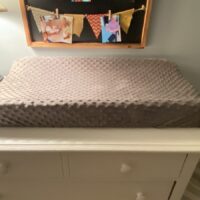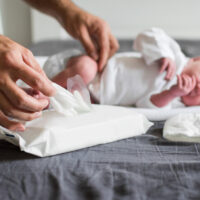During the first few days of life, your baby may only have a few wet diapers per day. This number increases to 6-8 wet diapers daily thereafter and can increase as your baby gets older.
Below, you’ll learn everything you should know about wet diapers and what they mean. You’ll also discover what is an appropriate feeding schedule, and what to do if your baby isn’t taking enough breastmilk or formula.
Why You Should Track Wet Diapers
Your baby’s wet and soiled diapers are a great indicator of how well they are eating. In the past, pediatricians provided parents with infant feeding schedules. It’s now recommended that mothers feed on-demand. This is true for both breastfed and formula-fed babies which typically means feeding every two to three hours. Feeding on-demand, however, does not mean feeding when your baby just needs soothing or making them finish bottles when no longer hungry. Over-feeding causes issues such as excess weight gain (source). It can also make your baby spit up more frequently, losing much of the milk they have ingested.
In addition to learning and watching for your baby’s hunger cues, you should monitor their urine output. Infants rely on breastmilk or formula as their only source of nutrition and hydration during the first six months of life. This means that the amount of urine and stool they pass is directly related to their nutritional intake. Unless mom pumps her milk, it is difficult to know how much a breastfed infant is eating. Paying attention to the number of wet diapers helps to gauge whether or not the baby is taking enough breastmilk. This is particularly important during the first week of life when a mom may have difficulty with breastmilk production.
Babies and Dehydration
In addition to being sure that your baby is getting enough to eat, checking wet diapers ensures your baby stays well hydrated. 70 percent of an infant’s total body weight is water, compared to 60 percent in adults (source). Therefore, fluid losses in infants are more significant, and they become dehydrated much faster.
Dehydration in infants is very serious. The blood, major organs, and even in the bones contain water. With fluid losses, the body also loses sodium, potassium, and other electrolytes. An imbalance of these electrolytes causes symptoms such as fussiness, lethargy, and even seizures. In extreme cases, dehydration can even cause death.
If you are concerned that your baby is not drinking enough fluids, check for signs of dehydration (source). A good place to start is to record how many wet diapers your baby has in a 24 hour period. If it is less than six, they may be dehydrated. Dark or especially pungent urine can also indicate dehydration. Some other signs to look for include:
- Lethargy or extreme tiredness
- Dry eyes, mouth, and cracked lips
- A sunken fontanelle (the soft spot on your baby’s head)
- Dry or slack skin that doesn’t bounce back when it’s pressed
- Sunken eyes
- Tearless crying
- Extreme fussiness
Preventing Dehydration When Your Baby is Sick
If you believe your baby is dehydrated, you should never give an infant water prior to six months old (source). Since your baby gets food and water from the same source, breastmilk or formula, they don’t need additional water. Even after six months old, drinking too much water can cause babies to lose weight, and have developmental delays. In some cases, too much water causes water toxicity. Baby kidneys are immature, and release sodium into the urine. When too much is lost, this results in electrolyte imbalances in the brain. This can cause irritability, drowsiness, seizures, low temperature, and even death.
When your infant is sick, you can prevent dehydration by continuing to breast or formula feed. When your baby has vomiting or diarrhea, it’s important to replace the lost fluids. You should feed on your usual on-demand schedule, or offer smaller, more frequent feedings. If you baby will not feed, and shows of dehydration, take him or her to a doctor or emergency room.
How Many Wet Diapers Should My Baby Have?
When to Expect Baby’s First Wet Diaper
It can take up to 12-24 hours after birth for your baby to produce a first wet their diaper. If there are no birth complications, you’ll likely be spending time with baby soon after birth. Most mothers breastfeed within the first hour of their baby’s life. Even if you aren’t exclusively breastfeeding, mothers produce colostrum, a milky substance full of antibodies, sugar, proteins, and fats that boost your baby’s immune system. Because of these nutrients, most doctors recommend attempting to breastfeed if possible.
If you are formula feeding, offer 1-2 ounces every 2-3 hours, or whenever baby is hungry (source). Although the first feeding happens within the first few hours of life, it might be several hours before your baby produces their first wet diaper.
Red in Your Baby’s Urine
In your baby’s initial wet diapers, you may notice reddish-brick or rust-colored flecks in the diaper. These are uric crystals that form in highly concentrated urine (source). These red flecks are more common in breastfed newborns. Some parents may mistake these red spots for blood. This is not the case, and uric acid crystals do not indicate anything wrong with your baby.
How Many Wet Diapers in the First Week?
Your baby is going to have more wet diapers as time goes on. Even so, you should not expect a newborn to have lots of wet diapers during the first few days. By the third or fourth day of life, your breastmilk supply improve (source). If you are formula feeding, you may notice your baby wake to feed more often. As the appetite increases, so will the number of wet diapers. There’s a direct correlation between eating and how often your newborn pees.
By day 3-5, you should expect at least 2-3 wet diapers per day. Following the sixth day, your baby should be eating enough that they produce 6-8 wet diapers per day. Don’t worry if your baby experiences wetness more frequently; some babies go after every feeding.
What about After the First Week?
By two weeks old, you should continue to see 6-8 wet diapers per day. Some babies may even have 10 or more wet diapers. Even if your baby goes up to 20 times in a 24-hour period, it is okay. Their bladder only holds about one ounce of liquid, so they will empty it frequently depending on how much they are eating.
As the size of your baby’s bladder is grows, so does their appetite. A larger bladder can hold more urine, so babies will still have the same frequency of wet diapers.
How to Check if Your Baby’s Diaper is Wet
Newborns only have room for about one ounce of liquid in their bladder (source). If you are using cloth diapers, it’ll likely be easy to tell when your baby has a wet diaper. However, many parents use disposable diapers that are very absorbent, keeping moisture away from baby’s skin. This prevents rashes unless the diaper becomes saturated. Unfortunately, this can also make it harder to determine when the diaper is wet. Even baby diapers designed with an indicator might not always reveal wetness.
Odds are that you’ll need to take your baby’s diaper completely off to check it. Look and feel the dry diaper beforehand so that you know the difference. As the diaper absorbs urine, it will “puff up” a bit. This is due to the wood pulp fluff, super absorbent polymer, or other absorbent materials inside the diaper, expanding as it absorbs the liquid. If you aren’t sure what a wet diaper looks like, put one tablespoon of water onto a clean diaper and note any changes.
If your baby’s urine has an odor, you might be able to smell it in the diaper. (Don’t worry; this will be one of the least gross things you’ll do as a parent). You can also detect wetness by touching the diaper, either with a piece of tissue or your fingers. One parenting website recommends putting a single piece of tissue inside your baby’s diaper to determine if it is wet, but avoid doing this if the tissue breaks up or causes irritation.
FAQs about How Many Wet Diapers a Newborn Should Have
How often should I change my baby’s wet diapers?
Newborns urinate 15 to 20 times per day (source). If using highly absorbent diapers, you may not need to change the diaper each time. This is especially true for newborns who have small bladders, and produce only small amounts of urine at a time. Diaper manufacturers usually layer the absorbent material between the outer layers of fabric. This locks away the wetness so the portion that touches your baby’s skin stays dry. Cloth diapers will need to be changed more often since they do not have this absorbent material.
One single diaper is not expensive, but babies use a lot of diapers, and that cost adds up (source). Some manufacturers state that their diapers can be worn for up to 12 hours. This, however, is not practical because newborns pass stool several times a day. If your baby’s diaper has a wetness indicator, waiting until it has changed color is an option. You should also change the diaper once the skin contact layer is not absorbing all your baby’s urine. A diaper that is heavy or sagging is a sign that it needs to be changed.
This routine is not appropriate, however, for babies that have easily irritated bottoms. Diaper rashes are often caused by waiting too long between changes. However, it can also be the result of chafing from a poorly fitting diaper, or a sensitivity to the diaper’s materials. If you suspect your baby has sensitive skin, there are several hypoallergenic brands that use gentler ingredients. Airing out the area and using a diaper rash cream are good preventative measures.
What should I do if my baby doesn’t have enough wet diapers?
If your baby does not have a wet diaper at least six times per day, a doctor can provide advice on how to remedy this. If hot weather or illness are not the reasons, the most likely cause of decreased wet diapers is a feeding problem.
Mothers who bottle-feed have the advantage of knowing exactly how much their baby eats. When you breastfeed, however, it’s hard to know if your baby is just suckling, or getting enough to eat. In some cases, mothers do not produce enough breastmilk for their baby. At other times, the baby has difficulty latching onto the breast. Speaking to a lactation consultant can really help in these situations. Eating healthy, drinking plenty of water, and avoiding caffeine helps support breastmilk production. Some moms use certain herbs can also help with lactation, but you should consult a doctor first (source).
What color should my baby’s urine be?
The color of baby (and adult) urine is closely related to hydration levels. Urine is liquid waste that forms after the body processes food and fluids (source). A healthy urine color ranges from clear to a pale or a light golden yellow color. In most cases, it will be difficult to see your baby’s light-colored urine within the diaper, especially since they do not produce a lot of it when they are young.
If your baby has dark yellow or brownish colored urine, this means it is very concentrated. Dark urine is often a sign of dehydration which can be caused by a variety of things. In newborns, it can be a sign that they are not eating enough. This may occur when formula isn’t offered infrequently, or the mother’s breastmilk supply is low. It can also happen if your baby has trouble latching.
Look for signs of dehydration when your baby is ill, or has spent time in hot weather. Vomiting and diarrhea can also cause dehydration. Babies quickly become dehydrated while sweating from a fever or heat since their bodies cannot regulate temperatures in the same way as adults (source).
When should I take my infant to the doctor if they aren’t peeing enough?
If you catch dehydration early, you should be able to offer fluids orally, and get your little one back on track. This is one of the most important reasons to monitor your baby’s wet diapers. It gives you a warning before dehydration becomes severe.
Generally, you should start to worry if your baby has not produced a wet diaper in six hours. signs of severe dehydration such as tearless crying, extreme fussiness, being inconsolable, and a sunken fontanel are a medical emergency.
If unsure of the severity of dehydration, continue offering breastmilk or formula while calling your pediatrician (source). Even if it is after office hours, many pediatricians have an answering service to contact for emergencies. If you cannot get a hold of your pediatrician, it is best to take your baby to an emergency room. Especially with newborns, it’s always best to err on the side of caution. Dehydration can escalate quickly because they are so small.
How often should my baby be pooping?
Your baby’s poop schedule depends on what you are feeding, and how the body digests it. Breastfed infants are likely to have more frequent bowel movements than formula-fed babies. Some might even pass small stools after every feeding. It is normal for formula-fed newborns to go 1, 2, or even three days without pooping (source). However, if your baby is passing infrequent, hard, painful stools, talk to a doctor.
Babies have a black, sticky, tar-like stool called meconium on the first day or two of their lives. This poop is what your baby’s body eliminates after living in utero. By day 2-3, the stool should reflect what your baby is eating. For breastfed babies, this will be a mustard yellow color, and stools may be runny and seedy. Babies who are formula-fed may have green or brown pasty to formed stools. Different consistencies are normal.
Keep in mind that babies are “loud poopers.” Becoming red in the face, squinting, and grunting doesn’t necessarily mean that they are constipated. However, passing hard stools with bright red blood from an anal fissure means that your baby is probably constipated. If his is an issue, talk to your pediatrician to determine if they are truly constipated, and how to remedy it.
What will my doctor do if my baby is dehydrated?
When a baby becomes dehydrated, the next steps depend on the cause and severity. If discovered early, offering more formula/breastmilk over the next several days will replenish the water losses (source). Doctors rarely recommend Pedialyte or other drinks for babies under three months because they are usually too ill when dehydrated, and need hospital care. If you have an older baby, however, an electrolyte replacement fluid may be recommended if your little one is losing fluids from vomiting or diarrhea (source).
At the doctor visit, the underlying cause of dehydration will be discussed. This includes the feeding regimen. If your baby is not eating enough, you may be referred to a lactation consultant. This provider can also assist with latching and milk supply difficulties.
In case of severe dehydration, your baby will be admitted to the hospital. The doctors will closely monitor their fluid intake and output. If your baby is not eating, lost fluids will be replaced intravenously. In rare instances, a tube may be inserted through the nose and into the stomach to replenish fluids instead of with an IV.
Final Word
On-demand feeding is the recommended way to ensure that your baby stays hydrated and gets sufficient nutrition. Tracking your baby’s wet diapers helps you to know that they are well hydrated, and are eating enough. You should expect newborns to wet a diaper for the first time within 12-24 hours of birth. By the end of the first week, you should expect a minimum of six wet diapers per day. Knowing this can prevent dehydration, something that becomes serious in infants.
Hopefully, this guide has answered your questions about how many wet diapers a newborn should have. If you are concerned that your baby is not urinating enough, contact their pediatrician for reassurance and further guidance.
